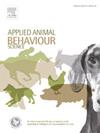The impact of enriched housing on the behaviour and welfare of captive leopard geckos (Eublepharis macularius)
IF 2.2
2区 农林科学
Q1 AGRICULTURE, DAIRY & ANIMAL SCIENCE
引用次数: 0
Abstract
Substantial evidence demonstrates the benefits of environmental enrichment in mammals and birds. However, far less is known about this topic in reptiles—an increasingly popular group of pets. This study compared the effects of housing conditions (Standard vs. Enriched) on the behaviour and welfare of captive leopard geckos (Eublepharis macularius). Within the Enriched housing condition, two different enrichment conditions were assessed: Naturalistic and Non-Naturalistic. Geckos (N = 6) individually experienced each of the three housing conditions for four weeks. Welfare was assessed by observing the behaviour of the geckos within their enclosure, followed by behavioural tests of anxiety (e.g., novel environment and object tests) at the end of the four weeks. The animals were then switched to the next housing condition, with order counterbalanced across individuals. This was repeated for all housing conditions, after which the geckos were given a preference test. Results revealed that when geckos were housed in Enriched enclosures, they exhibited a range of behaviours indicative of improved welfare (e.g., spent more time lying in the water bowl and less time interacting with barriers) compared to when housed in Standard conditions. However, we observed no differences in behavioural expression between the Naturalistic and Non-Naturalistic enriched enclosures. Although we observed no differences between Enriched and Standard housing conditions in the behavioural tests of anxiety, in the preference test, when given a choice between the three housing conditions, the geckos displayed a strong preference for the Naturalistic enriched enclosure. Overall, our findings suggest that enriched housing conditions improved the welfare of leopard geckos. Therefore, we recommend that geckos should be housed in enriched enclosures with, where possible, the inclusion of naturalistic features.
求助全文
约1分钟内获得全文
求助全文
来源期刊

Applied Animal Behaviour Science
农林科学-行为科学
CiteScore
4.40
自引率
21.70%
发文量
191
审稿时长
18.1 weeks
期刊介绍:
This journal publishes relevant information on the behaviour of domesticated and utilized animals.
Topics covered include:
-Behaviour of farm, zoo and laboratory animals in relation to animal management and welfare
-Behaviour of companion animals in relation to behavioural problems, for example, in relation to the training of dogs for different purposes, in relation to behavioural problems
-Studies of the behaviour of wild animals when these studies are relevant from an applied perspective, for example in relation to wildlife management, pest management or nature conservation
-Methodological studies within relevant fields
The principal subjects are farm, companion and laboratory animals, including, of course, poultry. The journal also deals with the following animal subjects:
-Those involved in any farming system, e.g. deer, rabbits and fur-bearing animals
-Those in ANY form of confinement, e.g. zoos, safari parks and other forms of display
-Feral animals, and any animal species which impinge on farming operations, e.g. as causes of loss or damage
-Species used for hunting, recreation etc. may also be considered as acceptable subjects in some instances
-Laboratory animals, if the material relates to their behavioural requirements
 求助内容:
求助内容: 应助结果提醒方式:
应助结果提醒方式:


